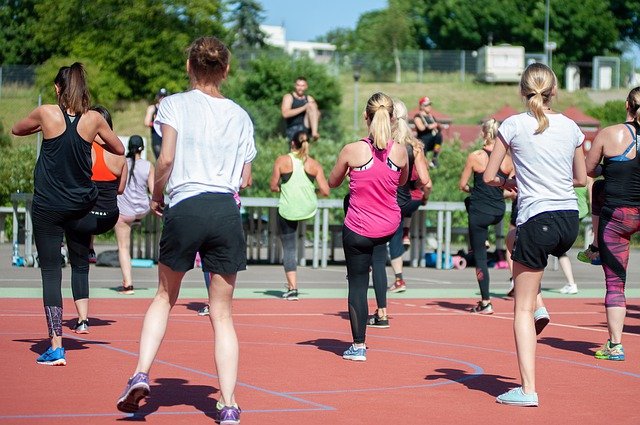
If you're intimidated by the gym, there are things to do before starting a workout. Warm up first before you begin to exercise. A warm-up will prepare you for your exercise and decrease the likelihood of injuries such as pulling muscles. This will reduce the buildup of lactic acid, which can lead cramps. It is important that you stretch and walk in the exact same spot throughout your exercise.
Don't over-extend yourself. Some exercises can be dangerous without the help of a spotter. Ask for one before you attempt new moves. Avoid pushing yourself during your workout, as you'll only make yourself feel worse later. Instead, take a rest after your workout and treat yourself. You can always return later and continue your training. If you are just starting out, it is a good idea to get started early and then increase the weight.

Cardio. Cardiovascular exercise should be a part of your gym routine. When you're working out, make sure to alternate between the upper and lower body. Try to do a half hour session if you are just starting out with exercise. If you find your workout is becoming repetitive or boring, it's time to change your routine.
Also, you can use dumbbells to lift heavier weights. Named after dumbbell goblet pushups, they are held in a goblet. These exercises are good for building a solid body. The dumbbell Romanian deadlift is a cousin to the bodyweight squat. These exercises are intended to build a strong and durable body. These techniques should be included in your daily routine.
Start by learning a few basics exercises if your first time in the gym. Next, work on your upper body using dumbbells or weightlifts. Because your lower body is the best place to build muscle mass, you should also focus on decreasing body fat. For a toned, lean body, lift weights for your upper body. You want a toned upper body.

A variety of equipment can help you get started with your workout. Cable machines are great for targeting multiple muscle groups. A leg press, which targets the quads and hamstrings, is a great way to build muscle in the legs. Kettlebells, which are cannonball-shaped weights with handles, are also excellent for strength training and cardio.
After you have finished your workout, it is time to do a warm up and cool down. It takes time for your body to cool down and warm up. Other than free weights, TRX suspension allows you to lift with your body weight. You can adjust the intensity of your workout with the treadmill, which is why it's the most popular piece.
FAQ
How do I find out what's best for me?
Listen to your body. Your body will tell you how much exercise, nutrition, and sleep you need. To avoid overdoing it, it's important that you pay attention to what your body is telling you. Take care of your body and make sure that you're staying healthy.
What are 10 healthy habits you can adopt?
-
Every day, eat breakfast.
-
Don't skip meals.
-
Eat a balanced, healthy diet.
-
Get plenty of water.
-
Take care of your body.
-
Get enough rest.
-
Avoid junk food.
-
Daily exercise
-
Have fun
-
Make new friends
How to measure bodyfat?
A Body Fat Analyzer is the best way to measure body weight. These devices can be used to measure body fat percentages in people who are trying to lose weight.
What does it take to make an antibiotic work?
Antibiotics are drugs which destroy harmful bacteria. To treat bacterial infections, antibiotics are used. There are many different types of antibiotics. Some are given orally, while some are injected. Other antibiotics are applied topically.
People who have been infected with certain germs may need antibiotics. An oral antibiotic might be prescribed to someone who has been exposed to chicken pox. This will prevent the spread of shingles. Penicillin might also be administered to someone with strep throat. This will help prevent the possibility of developing pneumonia.
A doctor should give antibiotics to children. Children are at greater risk than adults for developing serious side effects from taking antibiotics.
Diarrhea is the most common side effect from antibiotics. Other side effects possible include dizziness, nausea, vomiting, stomach cramps, dizziness and allergic reactions. These side effects are usually gone once the treatment is complete.
Statistics
- WHO recommends consuming less than 5% of total energy intake for additional health benefits. (who.int)
- According to the 2020 Dietary Guidelines for Americans, a balanced diet high in fruits and vegetables, lean protein, low-fat dairy and whole grains is needed for optimal energy. (mayoclinichealthsystem.org)
- Extra virgin olive oil may benefit heart health, as people who consume it have a lower risk for dying from heart attacks and strokes according to some evidence (57Trusted Source (healthline.com)
- This article received 11 testimonials and 86% of readers who voted found it helpful, earning it our reader-approved status. (wikihow.com)
External Links
How To
What does the term "vitamins" mean?
Vitamins are organic compounds that can be found in foods. Vitamins help us absorb nutrients from foods we eat. Vitamins cannot come from the body so food must provide them.
There are two types vitamins: water soluble or fat soluble. Water-soluble vitamins dissolve easily when they are dissolved in water. Examples include vitamin C,B1 (thiamine), B2 (riboflavin), B3 (niacin), B6 (pyridoxine), folic acid, biotin, pantothenic acid, and choline. Fat-soluble vitamins are stored in the liver, fatty tissue and kidneys. These include vitamin D, E and K, as well as beta carotene.
Vitamins are classified based on their biological activity. There are eight major types of vitamins:
-
A - vital for healthy growth.
-
C is important for nerve function and energy production.
-
D - Essential for healthy teeth and bones.
-
E is needed for good reproduction and vision.
-
K - essential for healthy muscles, nerves, and bones.
-
P - Vital for strong bones and teeth.
-
Q - aids digestion, absorption and absorption iron
-
R is required for the production of red blood cells.
The recommended daily allowance for vitamins (RDA) varies based on gender, age, and physical conditions. The U.S. Food and Drug Administration (FDA) sets the RDA values.
For example, the RDA for vitamin A is 400 micrograms per dayfor adults 19 years or older. However, pregnant women need 600 micrograms per day because it is important for fetal development. Children ages 1-8 require 900 micrograms per day. Infants under one year of age require 700 micrograms per day, but this amount decreases to 500 micrograms per day between 9 months and 12 months of age.
Children aged 1-18 years need 800 micrograms daily, while children overweight require 1000 micrograms per days. Children who are severely obese or underweight will need 1200 micrograms each day.
Children between 4 and 8 years old with anemia will need 2200 micrograms daily of vitamin C.
2000 micrograms are required daily for good health in adults over 50. Women who are pregnant or breastfeeding need 3000 micrograms per day due to increased nutrient requirements.
1500 micrograms is the recommended daily intake for adults aged 70+, who lose approximately 10% of muscle each year.
Women who have been pregnant or are lactating require more than the RDA. Pregnant women require 4000 micrograms daily during pregnancy, and 2500 micrograms every day after birth. Breastfeeding mothers require 5000 micrograms daily when breast milk production is occurring.